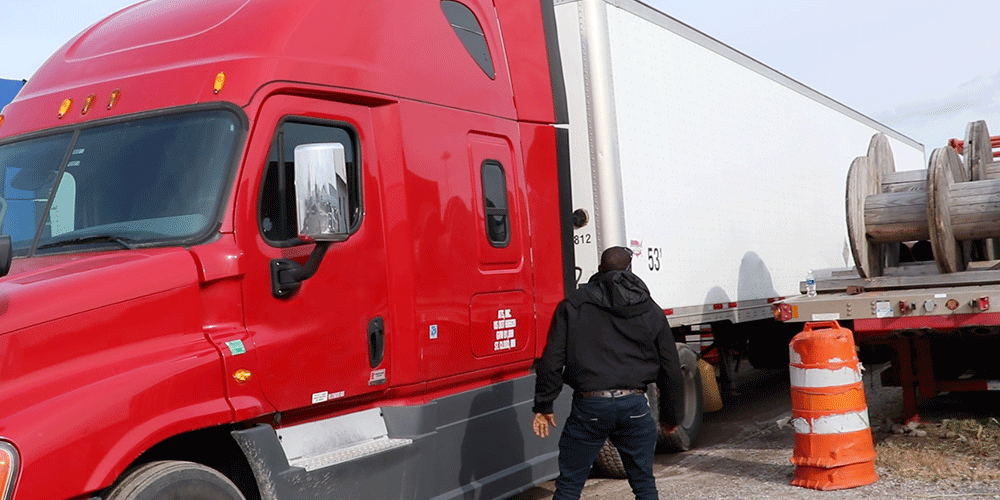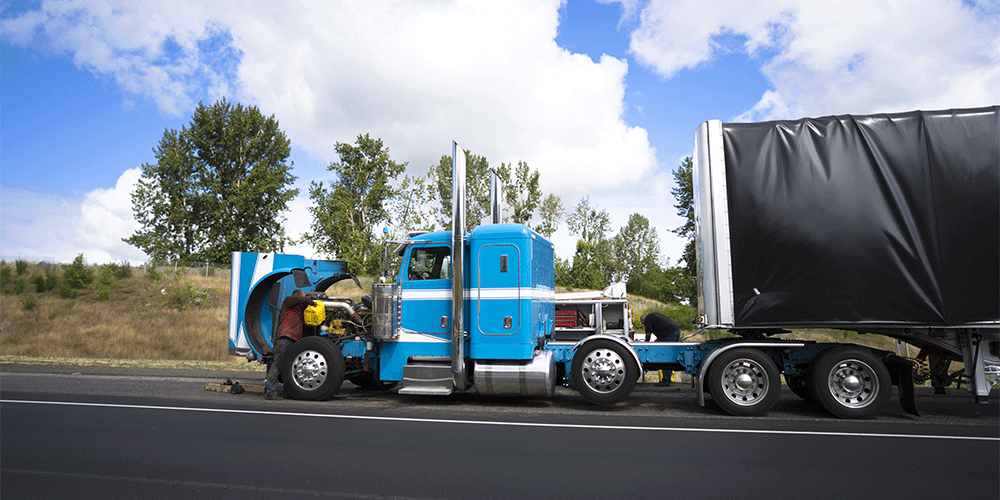Truck Driver Money-Saving Tips: Keep More of What You Earn
Samantha joined the Anderson Trucking Family in November of 2012 as a specialized driver manager and managed a fleet of mixed company and contractor drivers. In the spring of 2014, she transitioned to the driver administration department and began working in contractor services. While in contractor services, Samantha familiarized herself with all processes, procedures and information in regards to driver contracts, pay and settlements. She is currently the operations support manager and oversees both the contractor services department as well as the driver settlement department and leads both of her teams to ensure our drivers receive the highest level of service required to help navigate their accounts and settlements on a daily basis.
- Set a Budget
- Practice Safety
- Plan Your Trips
- Save Fuel
- Maintain Your Truck
- Don’t Be Picky About Freight: Plan Beyond Your Next Load
- Cut Down on Food Costs
- Stay in Your Truck, Not a Hotel
- Stay Out on the Road Longer
Not only does trucking give you the opportunity to enjoy the open road during every season, but it can also be a lucrative option. The average truck driver in the United States is taking home an approximate base salary of $92,793 per year.
But on the other end of the spectrum, there are stories about truck drivers going broke because they aren’t making enough money to cover their expenses — especially in this down market. If your paychecks are less than ideal, you may wonder how you can maximize your income or save a few bucks out on the road.
Here at Anderson Trucking Service (ATS), I’m regularly crunching numbers to help drivers like you save money. I’ll help you learn to save money for the things you want (and need) to spend money on, rather than spending it on the road.
If you feel like you’re losing more money than you’re making, you need to understand which factors have the biggest impact on your income. You can maximize your income by following these tips, including meal prepping, avoiding idling, planning your day, and route planning.
9 Ways to Increase Truck Driver Salary
The difference between success and failure comes down to nine key cost-saving practices.
- Set a Budget
- Practice Safety
- Plan Your Trips
- Save Fuel
- Maintain Your Truck
- Don’t Be Picky About Freight: Plan Beyond Your Next Load
- Cut Down on Food Costs
- Stay in Your Truck, Not a Hotel
- Stay Out on the Road Longer
Tip #1: Set a Budget and Stick to It
Budgeting is something you’re probably already doing as part of your regular “adulting” responsibilities, but it’s important to note.
Keep a budget that takes into account what your projected salary is and subtract your expenses from it. You certainly don’t need to be a penny pincher, but staying close to your set budget will help prevent you from having surprise credit card bills or an empty bank account at the end of the month.
Your budget should include operating costs (like fuel and regular maintenance), food, and normal bills you pay every month. Keeping this budget in mind on the road will prevent you from making unnecessary purchases.
Build Up Your Reserve Accounts
If you have the option, take advantage of your reserve accounts. Similar to a Health Savings Account (HSA), money is removed from each check and put into a savings account. The money can be used for specific purchases, like maintenance.
Having your reserve accounts built up when unexpected repairs come up will save you both stress and money.
Tip #2: Practice Safety: Get Out and Look
There’s a phrase we use here a lot at ATS, called GOAL. It stands for “get out and look.” Whether you work for ATS or otherwise, it’s an important practice to follow.
Before you hop in your truck and get out on the road, get out and look.
Make sure everything is hooked up properly. Check if everything is secured and meets safety standards. Do a quick inspection of your truck. Ensure that nothing seems to be out of sorts and that there is no damage. Inspect tires for signs of low pressure. Check lights, windshield wipers, and brakes. Adjust your mirrors and clear out any debris.
Failing to get out and look before you start driving can be a costly mistake. For example, a tire blowout can lead to a dangerous accident. At the very least, you’ll be stopped while you have repairs done on your truck. You may be left with the additional cost of a hotel, depending on how long you’re down.
In the past several months, the average cost of an accident was $2,600 for independent contractors. That’s just the cost of the accident itself — not taking downtime into account.
Consider “opportunity cost,” which is the amount of money you’re losing by not moving freight. Factors for that could include your operating costs, plus the money you’d be making under a load. We calculate opportunity costs to be roughly $1,050 a day for a driver.
So depending on the outcome of an accident you’re involved in, if you’re lucky, it’ll only cost you the upfront cost of $2,600. But we all know that’s not usually the case. You’ll likely be out of commission for a few days at a minimum — but it could be weeks. One week, plus the accident, could put you out $10,000 fast.
Taking the time to inspect your truck and drive safely will save both you and your carrier a lot of money.

Tip #3: Plan Your Trips
Trip planning is a great way to cut excess miles from your trip. Every mile you put on a truck has an expense, from maintenance to fuel costs.
Consider this: Going 200 miles off route can cost upwards of $1 per mile. That’s $200 extra spent on fuel alone — not to mention the wear and tear on your vehicle.
Take thirty minutes before you go to bed each night or thirty minutes before you start driving in the morning to plan your trip. What’s your way in and what’s your way out of delivery sites? Where will you take your 30-minute break and where will you stop for the night?
You waste time and money not planning where you’re going to shut down. If every truck stop you go to is full for the night, you may have to go miles and miles off route to find a spot to park. That expense adds up. Not only that, but you may have to pay for a parking spot. If you’re the last driver at the truck stop, it probably means that you’re the driver who didn't plan your trip.
Also, consider the route you’ll take if you run into construction or an accident. Hitting those construction delays makes your opportunity cost drop significantly because you miss out on those loads. It becomes a domino effect of missing one load, then the next, then the next. You may even have to deadhead to your next load.
Trip planning also includes being efficient with your time by calling customers ahead of time and offloading early if you can. If they can’t offload your freight early, you can plan to take your break sooner rather than waiting around. If you can be more efficient by picking up or dropping off freight early, you should.
Trip planning will not only save time, but it’ll also save you a lot of headaches.
Tip #4: Save Fuel
Fuel consumption is a controllable cost if you simply limit idling and drive “2-3 below the flow” (or two to three miles per hour below the speed limit).
If you’re speeding down the highway and leaving your truck on during every 30-minute break and at night, your fuel costs will be much higher than they need to be. An idling truck is also more susceptible to breakdowns and you may encounter issues with your diesel particulate filter (DPF) clogging.
Take this real-world example from one of our drivers here at ATS. He had repair bills of around $5,000, but because he controlled his idle time, his warranty covered the work. That meant he only had to pay his $1,000 deductible instead of being responsible for 100 percent of the costs.
While the driver in the example above didn’t have one, an auxiliary power unit (APU) can be a great investment for you if your truck has less than 50,000 miles on it. Why 50,000 miles? The cost for an APU can run about $12,000 to $14,000 to buy and install, which means it’ll take four to five years to pay for itself. If you won’t have your truck that long, that’s not a good investment.
If an APU doesn’t make sense for you financially, then consider getting a bunk heater for the cold winter nights and a fan for warm summer evenings. It’s no air conditioner, but it’s far cheaper than idling your truck.
Tip #5: Maintain Your Truck
Mitigate your risk: Hands down, preventative maintenance is one of the best ways you can prevent downtime in the future.
Do you notice a weird knocking sound? Is your service engine light on? Do not put off going in for repairs. If you're constantly pushing off repairs, you are more likely to end up being down more often in the long run. Failing to address problems now can make the problems even worse. It’s like an infection: If you don’t take the antibiotics you need to fight it, it’ll probably get worse.
It’s more important than ever to get your repairs taken care of efficiently with the current parts shortages. The part you need to fix your truck may be weeks out. If you take care of the problem before it becomes severe, you’ll be less likely to be sitting with your hands tied as you wait for a part.
While no one enjoys costly repairs and knowing you can’t prevent them entirely, doing your part to maintain your vehicle can help avoid costly downtime. Take care of your truck, and it will take care of you.
Tip #6: Don’t Be Picky about Freight: Plan Beyond Your Next Load
It’s so important to understand the freight market — especially if you’re an independent contractor. Is that load you’re about to pick up getting delivered to a place with no outbound freight opportunities? How far will you have to deadhead to find your next load?
That lucrative load won’t be very cost-effective if you have to travel hundreds of miles to find another load. This goes hand-in-hand with the next point: Don’t be overly picky. Consider this scenario:
Jim is parked in Texas because he heard there’s some high-paying freight headed out of there if he’s patient. Three days later — days of paying for food and gas — he’s offered a load that pays $3.25 a mile headed to Kansas City. He’s now having a hard time finding a load out of Kansas City, but he’s got an offer from St. Louis to Chicago paying $3 a mile. So he deadheads over there, picks up, and delivers. $2,650 later (before expenses), Jim’s feeling pretty good about his trip.
If you remember earlier, the average operating costs for independent contractors are between 90 cents and $1.15 per mile. Even if we say Jim’s costs were $1 per mile, he lost about $250 going from Kansas City to St. Louis without making any money to offset those costs. That’s not even taking the money he spent on gas and food while waiting for his first load into account, which you can assume was nearly $100 a day.
Meanwhile, Tom took a load right away instead of waiting. It was only paying $2.75 a mile and needed to be delivered in Tulsa. Then, he found a load in Tulsa headed for St. Louis, paying $3 a mile. Finally, he picked up a load in St. Louis, paying $3.25 a mile which got him back to Chicago. Not only did Tom make $2,875 before expenses on his trip, but his only empty miles were going from one receiver to the next shipper in each town.
Tip #7: Cut Down on Food Costs
Taking the time to prepare simple, delicious meals takes little effort but saves so much money on the road.
Think about it: How much money do you spend on the road if you buy all your meals? Consider that, on average, you spend about $10 for breakfast, $20 for lunch, and upwards of $30 for dinner. You could be spending as much as $60 per day! For just five days out on the road, that’s $300 that you could be using elsewhere.
While it’s nice to enjoy a meal out on the road every now and again, don’t make it your primary food source. Trucks with inverters allow drivers to invest in mini-refrigerators that run on battery power. Something simple like rice, vegetables, and some type of protein can be prepared in advance, packed into reusable containers, and stowed away in your mini-fridge.
It’s also easy to prepare healthy, delicious snacks. Take the time to pack fresh fruit, vegetables, boiled eggs, and good protein sources like nuts or protein bars.
Convenient foods are just that — convenient — but that doesn’t mean they’re the healthiest or most frugal option.
And if you do go out to eat now and again, having a mini-refrigerator in your truck will make leftovers last. Tuck them in your fridge and — boom — lunch is set for tomorrow. The fridge easily pays for itself.
Tip #8: Stay in Your Truck, Not a Hotel
Every driver enjoys a night in a hotel every now and again rather than spending the night in their sleeper cab. But doing so on a regular basis can really add up.
Even the most experienced drivers who are using the best deals and discounts to get more affordable rates on rooms can spend hundreds of dollars a month on hotels.
Unless it’s essential, try to avoid paying for expensive hotel rooms. You can make your sleeper cab more comfortable for sleeping by keeping it clean, investing in quality bedding, blocking out the light with blackout curtains, or drowning out the noise with a noise machine or earplugs.
Tip #9: Stay Out on the Road Longer
By staying out on the road longer, you can get yourself into better freight lanes. That’s a great way to take advantage of higher rates, more freight moving through an area — or both. The more you try to get home, the harder it’ll be to get into good lanes.
As you probably already know, when you’re an independent contractor, going home means not getting paid. Treat home time as a vacation. Budget for it so you don’t run short on money during your time off. You can also add money to your reserve account so you’re prepared when home time comes up.
Can I Make Money Truck Driving?
Yes, you can. But salaries vary heavily. A few pay factors include the type of driving you’re doing, how often you’re home, how many loads you’re hauling, experience, and freight costs. Following our tips will ensure you’re maximizing your income — no matter what you're paid week by week.
After reading our tips above, it may seem like there’s a lot you have to worry about when it comes to making a decent income. But with a little effort and planning, it isn’t as hard as it sounds. Once you get into the habit of following these tips, it’ll come as second nature to you.
And if you’re still struggling, get in touch with your driver manager. They can help advise you in the areas you’re having trouble with, like route planning.
You can also talk to other drivers about how they succeed out on the road. They may have meal-prepping tips and tricks that you haven’t thought of yet.
Putting the Tips into Practice
While it’s ultimately true that you don’t make money when you’re at home, if you do a little planning, you’ll be able to enjoy both home time and a sizeable paycheck.
Take home the pay you deserve. Don’t waste it by failing to plan.
As a Top-Pay Carrier, we offer high-paying opportunities for both company drivers and independent contractors. Fill out our application and we’ll answer any questions you may have.





